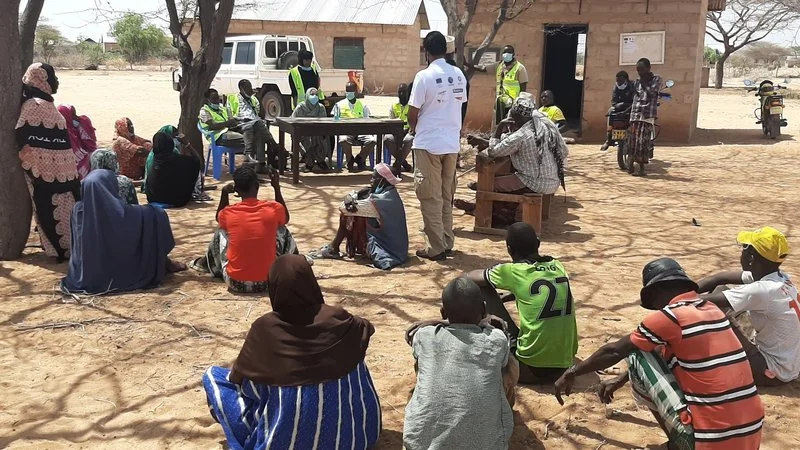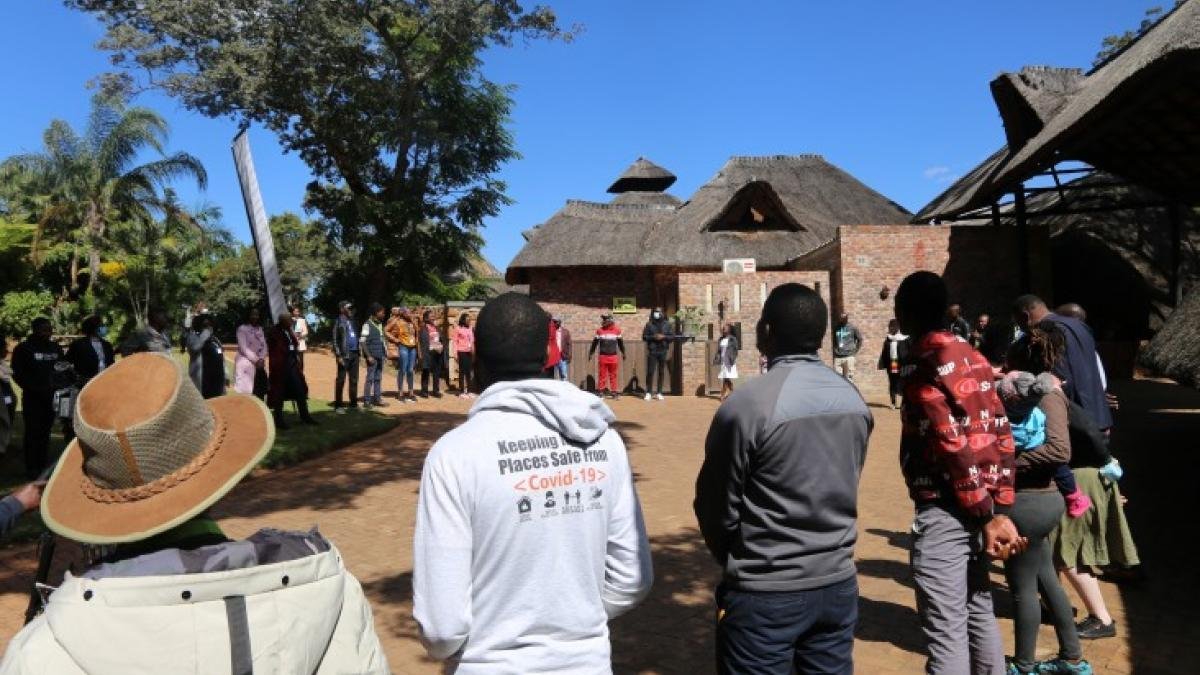CHALLENGES TO LOCALIZATION
CHALLENGES TO LOCALIZATION
This article captures the full range of notes and ideas about the challenges to localization, generated by workshop participants during brainstorming and small group discussions. The views and conclusions contained in this article are primarily those of non-USAID participants and should not be interpreted as representing the views, positions, or official policies, either expressed or implied, of the U.S.Government.
USAID
Challenges around Risk
Very low risk appetite; using taxpayer dollars and always the possibility of being audited.
USAID staff are generally risk averse; Mission directors ‘claim they have little power to change things’. Puts USAID at reputation risk - if Mission directors don’t run Missions, who does?
International partners are treated as less risky partners than local organizations despite significant comparative weaknesses, namely less country-specific experience and knowledge and less incentive to stay engaged in the long-term.
Challenges around Program Implementation
Unrealistic timelines for USAID staff, especially for getting outside capital to meet local organizations, producing deliverables, and building capacity among local partners.
Working with USAID entails much more than funding, but these additional elements are not adequately discussed and addressed.
Challenges around Relationships with Local Partners
Power imbalances in USAID’s contractual relationships with local partners.
Regional organizations that can and should play a greater role in USAID’s localization agenda tend to be excluded from relevant partnerships and networks.
Limited inclusion of local partners and leaders at every stage of projects; limited inclusion of diverselocal partners from different segments of a country’s population and different areas (rural and urban)in-country.
USAID’s goal to elevate local actors in procurement, implementation, and localization on equal footing with international partners is impeded by the financial and logistical challenge of convening local partners in-person, resulting in representation by proxy.
Challenges around Accountability
International partners undermine USAID’s localization agenda by registering themselves locally and citing local partners in proposals to which they ultimately do not allocate funds during implementation.
Many localization challenges named and recommendations made to USAID during these sessions have long been on USAID’s radar, suggesting that USAID has not adequately held itself accountable to its own goals.
There is an inherent conflict of interest between USAID’s reliance on seasoned international partners intent on maintaining their income and status quo, and USAID’s intention to devolve more funding and power to local organizations.
Challenges around Staffing and Culture
USAID is understaffed and existing staff are under-trained and under-resourced.
Foreign Service Officer system in which staff move post to post inhibits gains in local knowledge.
USAID staff are burdened by the obligation to meet competing targets (i.e. balancing localization targets with other federal targets).
Too little emphasis is placed on understanding why local organizations must play a bigger role in USAID projects.
The distribution of relevant risks, responsibilities, and opportunities between USAID/Washington and Missions do not optimize localization: too many are centered on USAID/Washington and too little flexibility and ownership are afforded to Missions.
Competition with China skews priorities and approaches.
ADS 203’s definitions of ‘locally led’ and the 25 percent localization goal metric are unclear,inconsistent, and not well understood by USAID staff.
There is a persistent narrative and unclear understanding that international organizations will always exist as intermediaries between USAID and local partners, contradicting the core goal and premise of USAID’s localization agenda.
Challenges to localization
Local Partners
LOCAL PARTNERS
Challenges around Procurement
Complex application processes and strict requirements deter and intimidate local partners with limited experience and capacity.
Exclusivity on bids.
Few opportunities to serve as primes.
System for Award Management (SAM) registration is very difficult for small, non-U.S.-based entities with little experience.
Stringent USAID requirements (such as prior USAID experience) preclude local organizations from applying for awards or render competition difficult.
Cost of responding to solicitations is too high; co-creation is time-consuming and costly at local levels.
Restrictive and controlling contracting mechanisms hinder local organizations’ participation due to limited financial and other administrative capacities.
Challenges around Reporting and Compliance
Due diligence and compliance requirements are incredibly burdensome for small and medium local organizations that are unable to apply for awards whose compliance requirements they cannot meet, and lack accessible opportunities to develop the skills needed to successfully pursue USAID opportunities.
USAID reporting requirements act as barriers to entry because they are too complex and onerous for local partners with limited capacity.
Challenges around Funding
Lack of funding, particularly compared with international partners.
Exchange rate volatility.
USAID grants are too large for local partners, who lack capacity to manage these funds and cannot compete with international partners for larger sums.
Funding commitments are too short, preventing local organizations from planning for the long-term.
The current de minims rate is too low for local partners.
Challenges around Capacity
Staffing
Trained and skillful local staff are driven away from local organizations towards international partners that can offer higher salaries, resulting in the loss of skilled personnel in local organizations.
Turnover between emergencies in fragile contexts.
Inertia: lack of experience inhibits local partners from building skills and experiences.
Time: timelines are too short for local partners with limited capacity.
Complexity of USAID projects and bureaucracy: working with USAID requires high levels of skill and complex management systems in which local organizations are not capable of investing to competitively develop.
Challenges around Accessibility
Difficulty accessing important information, including resources to inform competitive proposal development and relevant information from other organizations.
Language barriers inhibit localization because applications and best practice resources are not always available in local languages, and reporting is not accepted in most non-English languages.
Challenges around Communication
Communication between USAID and local partners is limited and tends to be inconsistent and unclear.
USAID provides little feedback on proposals to local partners, preventing them from improving their applications and becoming more competitive.
USAID provides little or inadequate guidance on the paths that local organizations can take to receive funding.
USAID shares information that tends to be too complex and difficult for smaller and inexperienced local partners to digest.
Challenges around Competition
Local organizations must compete with one another for limited funding opportunities in the same spaces.
Local organizations struggle to compete with well-established international partners with long-standing connections to USAID.
Challenges around Local Context
Local priorities do not win.
Solicitations do not reflect what local organizations want to address.
USAID needs to invest in developing deeper and more nuanced understandings of local demand, priorities, and cultural context, including intercultural dynamics and DEIA, to avoid imposing a top-down, one-size-fits all localization agenda that overlooks local needs and desires.
Lack of flexibility in funding, reporting, and compliance renders it difficult for Missions and USAID contract mechanisms to adapt to and accommodate local partners’ differing contexts and capacities.
Challenges Related to Trust
Many local partners do not trust U.S. organizations to build sustainable capacity or capital.
Many USAID projects start with local organizations but they get little funding as implementation progresses or they are cut out of budgets completely.
CHALLENGES TO LOCALIZATION
International Partners
INTERNATIONAL PARTNERS
Challenges to the Business Model
International organizations have business models that make localization challenging, especially without direct USAID support for it. International organizations fear no longer being funded, although the validity of this fear is unproven. A paradigm shift and change in operating model is required in resources, mindset, and financial incentives.
Lack of incentives for international organizations to partner with local organizations–specifically lack of requirement to sub to local partners; in contrast metrics of success typically include revenue generation, acting as a disincentive to sub-contract.
International organizations have to consider what happens to their local staff. How can international partners help them shift their role as localization advances?
Challenges for Procurement
Hard to know the best local partners or skill sets needed for the implementation phase.
Limits in Request for Proposals (RFPs) on the amount of funding prime contractors can set aside for local partners.
Need to identify pre-financing or other methods to underwrite contracts for local actors/consortium.
Contractual requirements make it difficult to partner with local organizations–USAID wants international organization contract compliance but with local partners who may not have the systems required.
Lack of flexibility and innovation in contracting; can be difficult bringing in local partners under various contracting mechanisms (especially if they are not registered).
USAID expects international organizations to carry the compliance risks of working with local partners–that acts as a major financial and reputational disincentive.
Challenges around Diversity of International Partners
Diversity within the international organization community means that challenges for international partners are different; this is often not understood or addressed in discussion of solutions. International partners need to be segmented to better understand and target challenges.
Cooperative agreements that are used to advance localization hinder small business utilization.
Local organizations may prefer partnerships with large international organizations that bring larger resources (e.g. business development capacity), reducing opportunity for smaller international organizations.
Challenges around Local Partner Relationships
It can be challenging to find local partners and a limited number of local partners makes partnership challenging in an environment of high international partner competition (e.g. non-exclusive teaming agreements).
International partners don’t have funding specifically to incubate/accelerate local partners.
The cost of doing capacity development - financial, administrative capacity - is not included in scope of required implementation issues; this includes issues like funds to invest in local talent to meet rigorous Chief of Party requirements.
Speed of implementation required by USAID makes local partnership challenging; there is little time to build capacity of local organizations when working under aggressive work plans.




